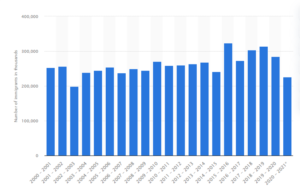Due to severe shortages in the healthcare sector, foreign-trained medical professionals have excellent prospects of gaining employment in Canada and eventually becoming citizens. As now the country Canada is looking for the requirements that they need to fullfil because they are facing lack og shortages in terms of trained doctors.
Shortage of Doctors in Canada
There is a critical lack of healthcare workers in Canada. The Canadian Medical Board (CMA) issued a dire warning in early 2022 about the country’s dire need for additional healthcare professionals. Two years into the epidemic, groups representing health professionals throughout the nation are raising the alarm that Canada’s health care system is failing. There is little chance of success if we don’t take action right away. It may be getting better for the average Canadian, as public health restrictions are being relaxed, but health care providers still have a long way to go.
Pandemic has created shortage in Canada
The 2 years of COVID-19 have taken a toll on healthcare personnel, leaving them severely exhausted and burnt out. Now, they must contend with significant system long delays and a lack of colleagues to help meet rising patient demand. As a result of severe shortages in the healthcare workforce, anada is actively recruiting medical professionals with international training. Also, there is a high demand for medical professionals in Canada but a low supply of medical schools, many Canadians who are denied entry choose to pursue their medical education in other countries, such as the United Kingdom, Denmark, Israel, british United States, and the Caribbean.
Canada has been working hard to make it easier for international medical professionals to immigrate there and have their credentials recognized. As part of these changes, additional residency positions will be made available for graduates of foreign medical schools.
The provincial and federal governments of Canada recognize that foreign-trained medical professionals who want to work and reside in Canada have difficulty in gaining credential recognition. It is well-known that many international professionals have difficulties obtaining work in Canada due to difficulties in having their qualifications recognized or in finding efficient means of having their credentials improved to meet Canadian criteria (re-credentialling). I have also found that there are more medical licensure and regulation in Canada is handled just at provincial level. The federal government is contributing cash to encourage the regional governments to enhance the procedure. There was $115 million allocated for it in the most recent federal budget. The shortage of residency positions is a significant barrier for international medical graduates who want to work in Canada.
The Ontario Fairness Commissioner, the Ontario Medical Association, and the College of Physicians and Surgeons of Ontario have all proposed increasing access for internationally trained physicians (IEPs) and increasing the number of residency positions available to IEPs as a solution to the healthcare crisis. In order to perform medicine in Canada, non-Canadian citizens are required to have a degree from a medical institution recognized by the Canadian government. The World Directory of Medical Colleges is where you may check to see whether your institution is included in the worldwide network of medical education. If you are looking for your school, “Canada Note” may be found in that online directory. Therefore, graduates of this medical school will be recognized by all Canadian medical associations and regulatory bodies.
The first step for a newly minted MD is to pass the MCCQE Part 1 test, administered by the Medical of Canada. In addition, they need to score well on the National Professional Collaboration (NAC) Test, which is used to determine whether or not an applicant is ready for a residence program in Canada. To practice medicine in Canada, a medical graduate from outside the country must first get a work visa from the IRCC and then apply for a postgraduate residency position via the Canadian Residents Matching Service (CaRMS). It is the responsibility of CaRMS, a national organization, to place Canadian medical school graduates in appropriate residency programs throughout the country.
International applications for entry level work in Canada
According to reports, international applications for entry level work in Canada dropped by 40% between 2013 and 2022, going from 2,219 to 1,322. This is according to the Canadian Homeowner Matching Service (CaRMS), a national organization that fits medical school educators with postgraduate training residencies. There is growing consensus amongst experts that expanding the number of residencies available to overseas medical school graduates might assist Canada address its physician labor problem. If they are accepted into a residency program in Canada, medical professionals who were educated outside of the country will work under the supervision of a Canadian medical institution for a minimum of two years. Then, they’ll join the Academy of Family Doctors of Canada after passing their family medicine certification test (CFPC). Finally, the physician must apply to a medical board in a province or territory for permission to practice family medicine. Just under one-third of all Canadian doctors have an international educational background, and this is especially prevalent in the field of family medicine. However fewer and fewer foreign-educated medical professionals are making the effort to compete for Canada’s shrinking pool of residency slots.








